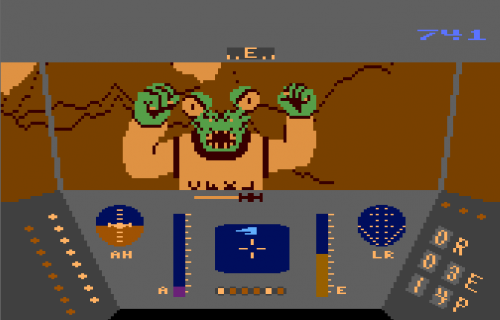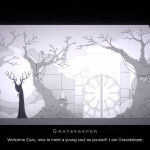This is the twelfth article in the Where We Came From series.

Last week, Electron Dance looked at the origin of Lucasfilm Games and their first title, Rescue on Fractalus! designed by David Fox. David is most likely remembered for his graphic adventure Zak McKracken and the Alien Mindbenders (1988) although he also contributed to Maniac Mansion (1987) and Indiana Jones and the Last Crusade: The Graphic Adventure (1989).
Electron Dance recently caught up with David to chat about his Lucasfilm days and the resulting conversation is presented in two parts. This week, we discuss the growth of the Games Group and the development of Rescue. Next week, we talk about Lucasfilm Games moving into graphic adventures, why David left LucasArts and what he has really been trying to accomplish for the last thirty years.
Let the words begin.
Throwaway Games
HM: Okay, David, let me ask a little about what the “Lucasfilm Computer Division Games Group” was like in the beginning. The Computer Division was tasked with researching computer graphics and Games was just a small part of that. How many people did you have at the start?
The first person hired was Peter Langston to be the manager of the group. Then Rob Poor transferred from a position he held in the Computer Division to help us with tools. Then I was hired, end of summer 1982 and Dave Levine a month later. I think by the end of the first year, we had about eight members. By the time we moved to Skywalker Ranch in 1984-85, about fifteen. When we left the ranch in 1990, we had 60-70 and were growing fast.
It was pretty exciting to be a part of it at the beginning. We all felt under a lot of pressure due to expectations created by the buzz of our group starting up. Magazines were basically expecting us to deliver the “Star Wars” of the video game world. Internally, though, that was softened by the R&D nature of what we were doing.
We weren’t expecting to hit a home run on our first time out there. In fact, the first two games we worked on were considered “throwaway games” – if they sucked, we just would drop them and chalk it up to experience. When they actually turned out to be really promising, we shifted into production mode.
It took a while for us to all realize that this shift was happening and I think that caused some problems, and a bit of schizophrenia, when we were partway through the transition.
HM: What kind of problems?
New pressures, the concept of DEADLINES rather than “work on it until it’s ready.”
HM: Ah, interesting – I’d wondered if the atmosphere at the Games Group had been laid back and relaxed. I can see how that shift would have been problematic.
Initially, very laid back. No deadlines. Just a directive to learn how to create awesome games.
This shift also caused us to have to hire new people. For example, Steve Arnold became the new general manager of the group because of his track record of completing dozens of titles as the head of a group within Atari. And Peter Langston, who was much more research-oriented, ended up choosing to leave a while later. That was painful for all of us. Steve was a great match for our new production-oriented mode, but we were all really sad to see Peter leave. It made it clear that the first era was over.
Star Wars, No Thanks
HM: It’s interesting that the group started using people who were not seasoned game developers. As a result it felt like your team had torn up some kind of game dev rulebook and worked from scratch. Do you think any of Lucasfilm Games’ initial success can be attributed to “reaching outside the box” in this way?
Yes, definitely. We all had some experience in computer games, just not with a typical large company, like Atari.
Peter was well-known for his PSL games tape, a bunch of games that worked on UNIX systems that were often available on University minicomputers. Dave Levine had created games on the PLATO platform in Chicago. I had just completed a book on Computer Animation (Computer Animation Primer) that focused on the Atari 800, and had been reviewing and converting games to various microcomputer platforms for 5 years.
So we were all very interested in games and creating them but we hadn’t been indoctrinated by the “right way” to create them by being a part of a large established game company.
Peter thought that maybe the way to go was to first simulate the games on high-end computers. He created an early version of Rescue on Fractalus! on an Evans and Sutherland vector graphics computer. It let us try out a few concepts before trying them on the Atari.
His hopes were to be able to make a version of the game on a VAX microcomputer, then push a button and have it automatically compiled for the target platform. We soon realized that this wasn’t going to be possible with the 8-bit micros at the time, where you had to coax every ounce of speed out of them through tight assembly language coding.
HM: Yes, back then it was absolutely vital to program like that, sometimes at the expense of neat, structured code. And especially with something as processor intensive as Rescue must have been.
And not just processor intensive – our first two games took advantage of the Atari’s graphics processor, using tricks to make it all look great and get the best frame rates possible. Ballblazer was actually updating the screen at 60fps! That was unheard of back then.

HM: So it’s interesting that the first set of games – Rescue on Fractalus!, Ballblazer, Koronis Rift, The Eidolon – all demonstrate high-class polish which, while not unique, was relatively uncommon. Would you say these were very corporate games or they still had their roots in the “bedroom programmer” generation?
No, not corporate. At least not in the sense of many of today’s games where they might be marketing-driven. We were very much on our own. No one said, “I think you need a sports game now.”
HM: Ha ha.
We had the freedom to come up with anything we could dream up and create… as long as it didn’t take place in the Star Wars universe. Star Wars was off limits during the 80s.
HM: That was probably good for your creativity.
Absolutely. Though I, at least, was bitching and moaning about not being able to do a Star Wars game at first. In retrospect, it was a huge gift.
We were forced to be creative, inventive, without relying on a proven license. Another side benefit of not doing Star Wars games… we were basically left alone. If we had been doing one, then licensing would have been looking over our shoulders, and George probably would have been too.
HM: I must jump in here and say how I love the story about how George Lucas, when seeing Rescue for the first time, said that you needed to be able to shoot things, overturning the pacifist ethos you’d built into the game. This, as well as his suggestion to inject some tension into the pilot pickup sequence, definitely changed the game for the better. How often did Lucas actually get involved in the workings of Lucasfilm Games?
That was pretty much it. He spent about 20-30 minutes with me that one day. And about the same amount of time with Dave Levine [author of Ballblazer] right afterwards. When the next few rounds of games were in beta, he did come in for a demo but by then the games were pretty much locked down.
I don’t think he even saw demos after that.
HM: Was he too busy or had you earned your autonomy?
Good question. I always assumed it was that he wasn’t all that interested in getting involved, that he really wasn’t a computer game player at heart.
HM: I’ll follow up with George if he’ll grant me an interview.
Hah!
Vrooom!
HM: Now the alien scare in Rescue is undoubtedly one of those iconic moments in Atari gaming. Completely omitted from the game’s manual and marketing, knowledge of this “secret alien” initially spread through word-of-mouth. Players had to see it for themselves, to verify it wasn’t just some urban legend because, frankly, it sounded incredulous for 8-bit technology. Today, even if marketing could keep quiet, within days there would be screenshots, YouTube videos and forums filled with evidence of any secrets. Would it still be possible to pull off a surprise like this?
Hmm… probably not. Maybe we had at least partial success of keeping it secret because those who experienced the shock of the alien pop-up firsthand wanted the experience of shocking their friends with it… “Come on over, check out this game…” then vrooom!

HM: Ha! I did exactly that. Took a heck of a lot of flying around and leaving empty ships in my wake hoping Jaggies, the aliens, would commandeer them.
When I did public demos, I used a hacked version that let me force an alien to come out when I held down a button. Definitely helped with the drama of it all.
“Oh, what’s this? Something looks different here….”
I also liked demoing what happened if you failed to open a door for a pilot… finding that moment right after he plops to the ground but before he’s completely dead.
HM: I started to leave the doors open because I found the alien a little too scary. That’s a bit dangerous though…
Yes, especially if the mother ship hadn’t arrived yet. Something about having the alien in the back of the ship, tearing it apart, must have been very real to some, though. Someone once congratulated me on the effect of having the alien’s arm reaching around from behind you and grabbing you. That was never was in the game… just in this gamer’s imagination.
Regarding keeping the Jaggi a secret – we did get Atari to agree to not feature it in any of their marketing but it was shown at the initial press conference when we launched the game. Probably not much of a surprise to gamers by then since anyone who wanted to was able to grab a pirated version six months earlier.
HM: But it was stirring stuff. I can’t think of something else at the time which evoked such fear – perhaps Space Panic in the arcade which always used to freak me out when the monsters grabbed you. Sound effects were how to get to players back then. Still are, really.
Yes. I knew what kind of sound I wanted and was able to describe it to Peter, who then synthesized it on our Yamaha keyboard. Charlie Kellner was then able to duplicate it for the game.
Watching the Jaggi pop up without the sound isn’t anywhere as scary. I still get an occasional e-mail from someone telling me about their first Jaggi pop-up experience. Always fun to read them.
Piracy
HM: Going back to the technology. Fractals made it into three of the first four games but with the departure of Charlie Kellner and Loren Carpenter, the knowledge behind the code was lost. I don’t recall anyone else ever doing the same thing, giving Lucasfilm Games a very unique position in the video game history of the 80s. Do you think more could have been made of this technology?
Well, Loren was never really a part of Games, he was on part-time loan to us from the Computer Division during the creation of Rescue (he’s now the chief scientist at Pixar). Charlie totally understood the tech behind it and was able to turn the fractals upside down in The Eidolon so they represented the walls and ceiling of a cave.
Soon after, though, I think much of our efforts split off in two directions: graphic adventures and military sims. The sims were going after realism, but didn’t need fractals in the same way. Still, it would have been fun to see how they looked on PCs with decent graphic cards.
HM: How much did Rescue go for on release?
Maybe $40? Not sure.
HM: Sounds about right. It’s funny to think in today’s money games were extraordinarily expensive. That $40 is about $90 today.
Wow. Well, how much was an Atari 800 with full RAM in today’s money?
HM: You could buy a house probably for the same cash value. At the height of the bubble!
Hah!
HM: So at those prices, lost sales had a significant impact on the bottom line. This is more anecdotal but I think the conversion rates – from pirate copy to purchase – were extremely weak as the act of buying was more physical. Less use of credit cards, no click-to-buy. So piracy was a serious blow to any company. The leak of the unprotected version of Rescue from Atari, six months before release, would no doubt be demoralising.
Leaks continue to be a problem – Valve’s Half-Life 2 development team was stunned when their entire code base was leaked in 2003 – but piracy is being viewed in some quarters as part and parcel of life, an unofficial marketing channel. Prices, save for mainstream titles on release, are being driven into the single digits with discount-led PR and mobile app pricing models. Do you still see piracy the same way?
Piracy before a game is released is deadly. Piracy six months before a game released is even worse! It totally ruins the specialness of the game. Everyone has already seen or played it by then.
Rescue was traded around in Atari user groups and available for download in the BBS’s. Piracy that happens a few days or weeks after a title is released isn’t as bad and you then have the option at least of actually paying for it if you like the game.
Now I think piracy is a fact of life and can be considered a part of marketing the game. Also, nowadays, with anyone being able to download a pirated mp3, I think transferring that ethic over to games means most people don’t think twice.
I do know that some percentage who love a game they downloaded illegally, or “borrowed” from a friend, will then go and pay for it. Others would just never buy it, though, so in that case, I can’t think of it as a lost sale.
So, when the people who don’t have a budget to actually buy a game grow up, get a job, and have disposable income, hopefully they’ll have fond memories, or a bit of guilt, and buy a sequel to the game…
Art
HM: Various Easter eggs in Rescue reveal the names of the design team behind the game. Not putting the authors upfront reminds me of Atari’s notorious practice of treating programmers as factory floor workers churning out commodities – uncredited and paid a low salary. Of course, that led to a group of 2600 programmers quitting to start Activision.
Well, on the issue of getting credits, for all the time I was at Lucas, everyone on the team did get credits but at first not on the screen. Either on the box or in the manual. That may have been Atari’s restriction.
HM: Back in 1983, Brian Moriarty discussed Atari’s no-credit policy in an A.N.A.L.O.G. Computing editorial and offered the following questions: “Are video games works of art? If so, do programmers have the right to sign their work?” Of course, when there were only one or two hands on a project, you might say “this is my piece of art” but when it’s cooked up in a bubbling cauldron of skill sets it’s a bit more difficult to think of a signature on a piece of art. Do you see computer games as works of art?
When I was creating games at Lucas, I never considered whether they were “art” or not, nor did I really care. I actually didn’t start creating games because I wanted to be working on home computers or consoles… I wanted to create compelling entertainment that was immersive in ways that films couldn’t be.
But clearly games can be art. And there are plenty of films that I could argue aren’t art. Probably the majority.
HM: Not even Star Wars?
That’s definitely art!
If I give something 8 or more on a scale of 1 to 10 then, for me at least, it’s probably art. Or entertainment so refined that I could put it in a special class of art. But I don’t really care whether games are defined as art or not. Games are games and at their best they can be awesome. So, the argument of “are games art?” to me seems like it belongs in a GDC debate but doesn’t impact most people.
Come back next week for the second half of the David Fox interview.
Download my FREE eBook on the collapse of indie game prices an accessible and comprehensive explanation of what has happened to the market.
Sign up for the monthly Electron Dance Newsletter and follow on Twitter!









